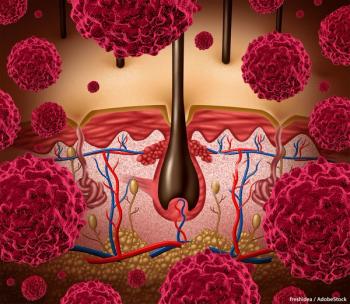
Women Have a 30% Survival Advantage in Cutaneous Melanoma
A new analysis of four large European trials of cutaneous melanoma patients showed a substantial survival advantage for women, most likely explained by underlying biologic differences.
A new analysis of four large European trials of cutaneous melanoma patients showed a substantial survival advantage for women, most likely explained by underlying biologic differences.
“Were the hypothesis of an explanation by sex difference in detection, screening, and diagnostic delays true, one would expect to see marked differences in the sex HR across prognostic subgroups presumably associated with these delays, particularly Breslow thickness and primary location,” wrote the study investigators, led by Arjen Joosse, MD, of Erasmus University Medical Center in Rotterdam, the Netherlands. The study’s results,
The investigators pooled results from four European Organisation for Research and Treatment of Cancer (EORTC) trials (Melanoma Group trials 18832, 18871, 18952, and 18961). Together, these trials included 2,672 patients with stage I/II melanoma, 48% of whom were men. At the time of diagnosis, men were older, more likely to have an ulcerated or thicker primary tumor, and were more likely to have melanomas on the head, neck, or trunk, and fewer on the extremities than women.
After adjustment for age, Breslow thickness, ulceration, localization of primary melanoma, treatment type, and lymph node dissection, women still had a significant survival advantage. The adjusted hazard ratio for overall survival was 0.70 for women vs men (95% CI, 0.59-0.83). Women also had an advantage with regard to disease-specific survival (HR 0.74; 95% CI, 0.62-0.88) and relapse-free survival (HR 0.69; 95% CI, 0.61-0.79).
The time to local recurrence was no different between men and women, but women also did have an advantage with regard to in-transit metastasis-free survival, lymph node metastasis-free survival, and time to distant metastasis.
“The 30% advantage extends to the whole spectrum of melanoma disease behaviors,” the authors wrote. “Even primary location, which so markedly differed across sex, does not explain this phenomenon; women had a survival advantage for both truncal and lower limb melanomas.”
All things considered, it appears likely that the survival advantages in women arise from some undescribed biologic differences, most likely specific to the host rather than to the tumor. Estrogen has been suggested as a possible contributor, but in this analysis the sex differences were similar for pre- and post-menopausal women, when estrogen levels drop substantially in women. Other biologic sex differences that could contribute include the fact that androgen receptors have been observed in melanoma cells, and differences in vitamin D metabolism between men and women. “Finally, because melanoma is immunogenic, sex differences in immune homeostasis might play a role,” the authors wrote.
The study is limited because of its meta-analysis design, but the stringent follow-up involved with EORTC trials makes the results more robust than otherwise. The investigators wrote that future work will focus on sex differences in metastasized melanoma. “Unraveling the underlying cause could be of therapeutic relevance,” they wrote.
Newsletter
Stay up to date on recent advances in the multidisciplinary approach to cancer.





